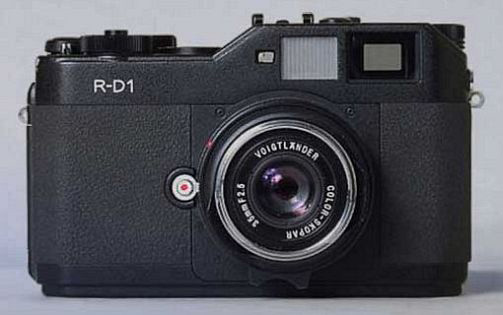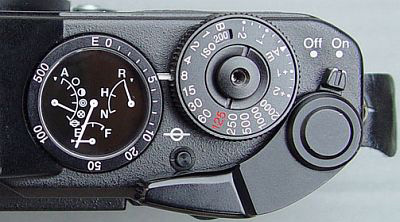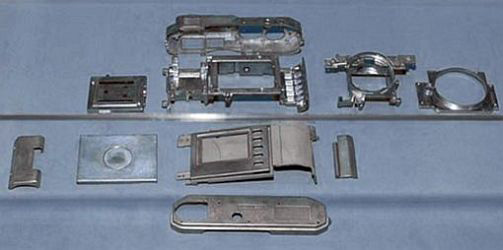CameraQuest Home Camera Articles FOR SALE Orders I Buy / Wants Repairs Books Adapters
THE EPSON R-D1 WEB REPOSITORY
|
Epson R-D1: Why I chose it
From SLR to rangefinder
My interest in photography began in earnest in 2003 – up till then I used a camera occasionally to take snapshots, with no attention paid to composition or image-making. For some reason, photography captured my imagination that year, and I bought a cheap film SLR. However, I soon became frustrated with the lack of immediacy and control of film, and bought a Canon 10D digital SLR. I was much happier using digital: I could see my results straightaway, and I enjoyed developing photographs in my ‘lightroom’ (I am very familiar with Adobe Photoshop as I use it at work).
After two years of use, I sold my faithful Canon 10D in 2005 to buy an Epson R-D1 – the world’s first digital rangefinder (Epson’s R-D1 website). I changed cameras because I found my relationship with my camera altered as I began learning about photography and how to use my SLR.

Figure 1. The world's first digital rangefinder, created, strangely, by Epson.
Back to the beginnings of my photography and my new digital Canon SLR ... At first I found my camera complicated and awkward to use. However, after a few months, I started to feel more comfortable, and began to use the 10D’s capabilities such as depth of field and deliberate choice of shutter speed or aperture routinely. Eventually, I started to concentrate on the image and not the camera; for those of you who recall learning to drive, I’d reached that point when you’re no longer conscious of the mechanics of driving – instinct takes over. In this final phase of my 10D ownership, I found the camera intrusive: it was indiscreet, bulky and heavy; and, most importantly, it seemed to dominate my picture-taking – for example, when a subject caught my eye I’d habitually zoom in and out, instead of walking to a better position, and I’d become over-reliant on auto-focus and matrix metering, allowing the camera to decide aspects of image-making that I should be dictating.
I became increasingly disatisfied with my 10D: I wanted a camera that I could dominate totally, not one that made decisions for me. To pick up my car analogy again, I was driving a family hatchback with power steering and an automatic gearbox but hankering after a stripped-down manual sports car.
My sister has an Olympus OM-1n with prime lenses – a 25-year-old SLR with no automation except centre-weighted metering. You have to focus, set the aperture and choose the shutter speed manually. It’s also tiny compared with modern SLRs. I’ve never used it, but began to think that it would be perfect for me – if it was digital!
Unfortunately, no one makes a compact, basic digital SLR with manual controls. I can, of course, turn off automation in my 10D, use small prime lenses, etc., but modern cameras don’t make this easy (manual focusing, for example, is awkward, with no split prism and no depth-of-field markings), and I would still have to contend with the camera’s bulkiness. Compact digital cameras don’t meet my needs either: compared with digital SLRs they have more automation, more options, shutter lag, smaller, noisier sensors and awful optical viewfinders (electronic viewfinders are even worse).
Whilst browsing the Web, I came across a review of a camera that began:
It’s a six megapixel camera with no autofocus, it only has center-weighted metering and either aperture priority auto or manual exposure. It has none of the usual handy features like auto-bracketing, continuous shooting or a movie mode … a digital camera designed to look, feel and operate like an old-fashioned 35mm rangefinder camera
and concluded:
The only analogy I can think of would be stuffing a turbocharger into a wood-framed Morris Traveller
After proving he had no idea how to use this camera, the reviewer gave it a rating of 2/10!

Another reviewer complained:
There are no extra perks of the modern digital camera, it just takes pictures.
This sounded like my type of camera!
(If you'd like to read what users of this camera thought of the first review, see rangefinderforum.com.)
The camera was the Epson R-D1, a digital rangefinder, with a horrendous price (£2000 without lenses) and a limited 10,000-unit production run. Looking at the R-D1 it seemed ideal: small, robust, large APS-sized sensor (identical to that in several SLRs), magnificent optical viewfinder, manual controls, analogue dials instead of an LCD panel, and interchangeable prime lenses.
So, after reading more-complimentary reviews by the experienced photographer Sean Reid, followed by a couple of months’ deep thought, I bought one at Christmas 2005, along with 21, 35 and 75 mm Cosina-Voigtländer lenses, hoping that I wasn’t making a serious mistake: I’d never used a manual camera, let alone a rangefinder.

Figure 2. The Epson R-D1’s funky indicator dials: more intuitive than an LCD.
The Epson R-D1 and the Canon 10D compared: rangefinder vs SLR
• I feel much more connected to my environment, and have a more-defined idea of what I am trying to do and say when I'm taking a photograph. With the 10D, I composed with the camera; with the R-D1, I compose in my mind, then bring the camera to my eye; the camera is no longer part of the image-making process.
• The basic but accurate centre-weighted exposure meter means that it’s necessary to anticipate how the meter will interpret a scene, and, if necessary, overrule it before taking a photograph: Does the scene average to a neutral grey in brightness, or are there dominant dark or light areas that must be compensated for? Do I want the exposure biased towards shadow areas or highlights? I prefer this way of working: the ‘intelligent’ matrix metering mode of modern cameras is not always predictable, even if it's reliable –surely, it should be me who decides whether to compensate for exposure in situations such as when a subject is backlit, not the camera?
• The viewfinder is a revelation, and is far bigger and brighter than the 10D’s. It has a 1:1 view, so I can keep both eyes open (I had to keep one eye shut with the 10D or I couldn’t see properly!). But there are major downsides: the viewfinder doesn’t match exactly what the lens sees, owing to framelines that show a maximum 85% of the scene (decreasing as the point of focus becomes more distant), and parallax errors (the framelines move to compensate, but the views through the viewfinder and the lens are never entirely coincident); also, there are framelines only for 28, 35 and 50 mm lenses, so lenses with other focal lengths are awkward to use (supplementary viewfinders are available, but aren’t particularly accurate or convenient). All this sounds daunting, but as time passed I began to learn how each of my lenses behaves, and how to compensate for these inaccuracies.
• As the rangefinder viewfinder does not zoom, framing with telephoto lenses can be awkward, and 135 mm (90 mm for R-D1, owing to it’s 1.5 ‘crop factor’) is considered to be the upper practical limit for accurate focus. Also, owing to difficulties in focusing, rangefinders aren’t suited to macro photography. I won’t miss long telephoto lenses, as I rarely felt the need to use them with my 10D, but I did take the occasional macro shot. Counterbalancing these deficits is the extremely high quality of rangefinder lenses and their exceptional lack of distortion, and the vast choice of Leica-fit lenses spanning three-quarters of a century.
• I thought manual focus would be difficult to get the hang of, but it soon became automatic. Also, for similar scenes (e.g. shooting landscapes with maximum depth of field, or people in towns) the lens can often be pre-focused and left: just set the lens to its hyperfocal distance or to an aperture for which subjects will fall within the depth of focus (‘zone focusing’ or ‘capture focusing’, depending on whether you move or stay stationary and wait for a moving subject to enter the area of focus, respectively). I prefer manual focus as I find that auto-focus cameras lock on objects other than the main subject – often just before I press the shutter!
• Having only prime lenses with manual focus soon brought an intuitive understanding of the connection between depth of field and aperture – something I found difficult to appreciate with an auto-focus zoom lens.
• The R-D1 is quicker to use than I thought, owing to the last two points: despite its manual controls, it’s usually as quick as an SLR. With the 10D I often found myself having to lock exposure or focus on objects other than the main subject, which I found a distraction.
• The R-D1 is fitted with the venerable Leica M lens mount, which allows hundreds of lenses spanning 70 years to be used. In contrast, the 10D can only use modern EF mount lenses.
• My very small but fast prime lenses (35 mm f/1.7, 75mm f/2.5) mean that evening and other low-light shots hand held without flash are a doddle compared with using the 10D, especially combined with the R-D1’s good high-ISO performance at 800 and 1600.
• The whole outfit, including a handful of lenses and a small flash, is very compact, and can easily be carried in my jacket’s pockets with room left over. And the camera itself is small enough to be carried around all the time, although it’s heavier than it looks.
• The R-D1 is very well constructed, with a metal chassis; the controls are also metal. As it was designed to appeal to users of traditional film cameras, it has an ‘analogue’ feel: the controls are all in the customary film-camera positions, and it uses a dial with needles to convey basic information instead of an LCD panel – dials are more intuitive to read. The lenses are a revelation: unlike the SLR lenses I’ve owned, they are superbly constructed – many are made of solid brass (even the lens hoods and caps!), and the control rings are buttery smooth and have no play.

Figure 3. The sturdy all-metal chassis of the Epson R-D1.
What I dislike about the Epson R-D1
• I’m not keen on the shutter crank, which must be used to cock the shutter after each shot: being unfamiliar with film cameras, I sometimes forget to turn it. (The camera is basically an unholy marriage between a modern Voigtländer Bessa rangefinder camera and a Nikon D70 – it would’ve made the camera even more expensive to redesign the shutter to cock electrically, thus eliminating manual cranking.)
• Although the camera is well constructed, it does fall down in one area: the LCD – the screen is easily scuffed as it does not appear to have a tough protective cover like the Canon 10D.
• Epson, unlike a traditional camera manufacturer such as Canon, does not have the infrastructure to adequately service the camera: faults are often rectified by returning a new camera after a long delay of several weeks, and despite some notable problems with the camera’s external raw software and internal firmware (e.g. the shutter needs two presses to fire in certain circumstances, and hot pixels aren’t mapped out), it took Epson over two years to release upgrades that address these basic problems. Epson seems to be repairing more cameras in 2006, instead of replacing them, but the long-term outlook for the R-D1 seems bleak.
• Lenses with focal lengths below 35 mm can show appreciable vignetting, owing to the design of rangefinder lenses, which results in a greater fall-off in light intensity towards the lens edge compared with SLR lenses. However, this can be removed easily using software tools. I’ve noticed another difference between rangefinder and SLR lenses: SLR photos are characterised by softness and distortion of straight lines at the edges of photos, whereas rangefinder photos (ignoring vignetting) are characterised by softness compounded by slight smearing – on balance, I think that rangefinder photos look better, but it’s taken a while to get used to the difference in appearance.
Conclusion
I feel that the Epson rangefinder suits me more than the 10D, although it’s a pity I had to sell the latter as rangefinders are not as good as SLRs at some tasks, such as macro and long telephoto shots. Admittedly, I could have kept the 10D, bought a few prime lenses and turned off most of the automation, but it would still be far from ergonomic, and, ultimately, why use a tool for which I have no emotional attachment? Technically, photographs from both the R-D1 and 10D are similar in quality, but I definitely enjoy taking photographs more using the R-D1; for me, that’s enough justification.
Epson’s seeming lacklustre committment to this camera, such as poor marketing, tardy software upgrades and inadequate servicing infrastructure, is a concern; hopefully the electronics will be long lived, and the mechanical components can be sourced (e.g. from Cosina).
My ideal camera would be a small manual SLR, such as the Olympus OM-1n that I spoke of, but with a digital sensor stuffed into it. Unfortunately, I can’t see that happening …
Postscript – summer 2007
I’ve just sold my R-D1 and bought a Leica M8. The R-D1 remains a fine camera, but its sensor technology was starting to show its age: I like large prints (A3 and above), and my decision was made after seeing prints from a Canon 5D, which were more defined owing to higher resolution, and had an increased tonal range. Also, although the R-D1 is a robust and well-made camera, the difficulty in sourcing spares and awkwardness in dealing with Epson were a concern.
I am very pleased with the Leica M8, and the image quality is amazing (reminds me of film transparencies). However, egonomically the Epson R-D1 is superior: the analogue dials convey more information at a glance than the M8 – you can only ascertain the white balance by delving into the settings menu; the white balance and exposure compensation, altered by turning a dial on the R-D1, are quick and intuitive to change, whereas these important controls can only (inexplicably) be accessed through, once again, entering the settings menu; and the R-D1 is quieter owing to its manual shutter-cocking mechanism – the electric motors of the M8 increasing camera noise and using more power.
Rich Cutler 2007
 Why I chose it
Why I chose it